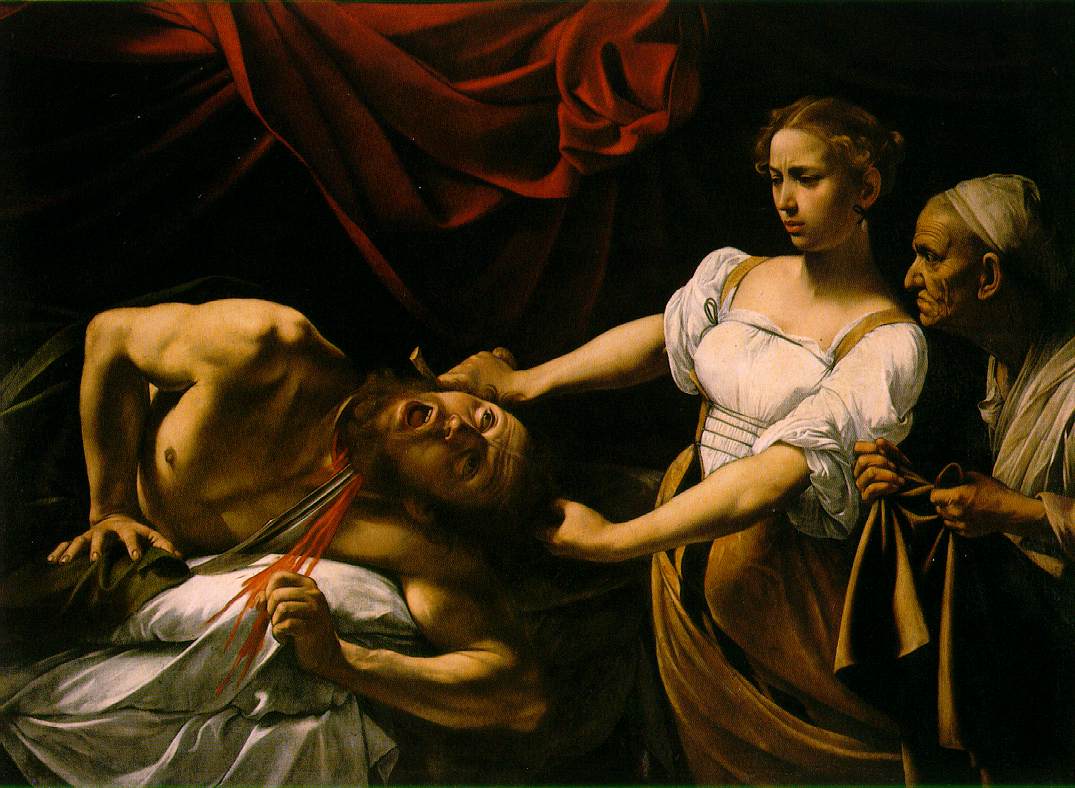Judith Beheading Holofernes
7:00 AM |
| Caravaggio, Judith Beheading Holofernes, 1598 |
By HARPER TRUOG
Holofernes was an invading general poised to attack Judith's city, Bethulia. As the city leaders were about to surrender, Judith walked into Holofernes' camp and used her womanly super powers of seduction to get the general drunk and distract him. She slept with Holofernes then slit his throat as he lay passed out from the alcohol. Judith is often seen with her hand maiden, an elderly woman, who holds the bag to put Holofernes' head in. Caravaggio captures the general's pain and surprise and Judith's determination perfectly. The old lady looks pissed at Holofernes for bleeding on the sheets; she looks like she just said, "He finally got what he deserved."
The red cloth above them could represent Holofernes' soul leaving, like in Caravaggio's painting of Mary's death. But, the fabric does not have the same upward movement, meaning that Holofernes' soul is not going to Heaven. The red cloth cold also mean that the threat to Bethulia dissolved with the beheading of the general. Bethulia's salvation came with the blood/head of Holofernes. Another interpretation is that the downward motion of the fabric is a divine force guiding Judith's hand. One of the folds lines up perfectly with her sword arm.
As much as I would celebrate Judith's actions, I doubt her fellow villagers would agree. She was an unmarried widow who slept with an enemy soldier, then she killed him. She may have saved her city, but a woman's worth at that time was based on their purity and softness. Judith's actions would have resulted in the degradation of her reputation and possibly punishment. I like to think that she knew what the repercussions could be and decided to carry out her plan anyway.
Holofernes was an invading general poised to attack Judith's city, Bethulia. As the city leaders were about to surrender, Judith walked into Holofernes' camp and used her womanly super powers of seduction to get the general drunk and distract him. She slept with Holofernes then slit his throat as he lay passed out from the alcohol. Judith is often seen with her hand maiden, an elderly woman, who holds the bag to put Holofernes' head in. Caravaggio captures the general's pain and surprise and Judith's determination perfectly. The old lady looks pissed at Holofernes for bleeding on the sheets; she looks like she just said, "He finally got what he deserved."
The red cloth above them could represent Holofernes' soul leaving, like in Caravaggio's painting of Mary's death. But, the fabric does not have the same upward movement, meaning that Holofernes' soul is not going to Heaven. The red cloth cold also mean that the threat to Bethulia dissolved with the beheading of the general. Bethulia's salvation came with the blood/head of Holofernes. Another interpretation is that the downward motion of the fabric is a divine force guiding Judith's hand. One of the folds lines up perfectly with her sword arm.
As much as I would celebrate Judith's actions, I doubt her fellow villagers would agree. She was an unmarried widow who slept with an enemy soldier, then she killed him. She may have saved her city, but a woman's worth at that time was based on their purity and softness. Judith's actions would have resulted in the degradation of her reputation and possibly punishment. I like to think that she knew what the repercussions could be and decided to carry out her plan anyway.
0 comments